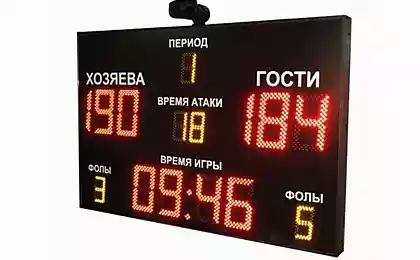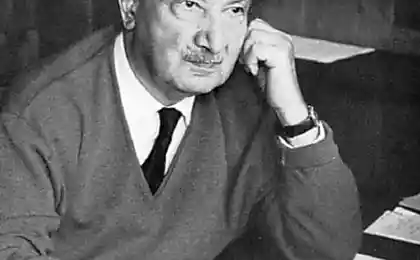1067
10 gadgets that changed the sport
Through innovation sports have become more spectacular
It's hard to imagine life without gadgets. Every day we are happy to use the benefits of civilization are not always aware of the fact how much has changed our daily existence. Sport, along with other spheres of life, too, was another - the invention of the twentieth century turned it into an exact science.
10 photos via rusrep.ru
1 electronic board
Start using
In 1964, an English football club, "Coventry" was first set at its stadium electronic scoreboard.
History
The first stadium scoreboards were mechanical. They used plates that had to be rearranged manually wheels and rails with figures moved along the windows, and the flip of a hard material. Of course, for such a service board was needed people is always close to him. Another disadvantage of mechanical scoreboard - the minimum information that it is able to display. Bill and team names - a larger count is not necessary. Later, there were electromechanical scoreboards. They differ from their predecessors was that they were equipped with motors or solenoids for remote switching of mechanical elements.
The new era of stadium scoreboards came after 1961, when the Americans Robert Bayard and Gary Pittman discovered and patented technology of infrared LEDs. However, in parallel with the LEDs in the stadiums has long been used incandescent lamps. At the Olympics-80 in Moscow thanks to the scoreboard showed a broadcast from the competition, but only in black and white.
What has changed:

Today, almost all major stadiums are equipped with video screens on which you can display the television picture, which is especially useful in such sports as biathlon or auto racing, where the viewer can not see the entire route. In addition to the score, you can find any statistical information about the players during the match broadcast or even see other competitions, as well as advertising - modern screens are almost universal.
2 Timing
Start using
Time in the sport for the first time was measured in seconds on the equestrian competitions in England in 1731.
History
First Chronograph, suitable for sports events, was made in 1820 by Swiss watchmaker Abraham-Louis Breguet. His creation is distinguished by the fact that there had been two second hands to fix the results of the two athletes. Gradually watchmakers improve its products, and already in 1862, the result can be measured with an accuracy of 1/5 of a second. Soon, however, and such accuracy was not enough, and in 1902 set a new standard - 0, 1 second. Since 1930 at the finish line began to mount the device with precision timing 0, 01 seconds. Watch companies are constantly working on improving the chronometers. At the Olympic Games in Mexico City in 1968, it has already reached the accuracy of 0, 001 seconds, and three years later came the first electronic stopwatch.
What has changed
Since 1973, the sports records in athletics is measured with an accuracy of 0 0001 second synchronizing via radio and the official chronograph quartz oscilloscope. In parallel, new developments emerged in other sports. So, thanks to the company Rado can instantly measure the flow rate of a tennis ball, and for swimmers by Omega in 1967 developed the so-called touch panel, which respond only to touch the athlete, ignoring the noise from the waves and water. At the 1972 Olympics in Munich thanks to them the Swede Gunnar Larsson at 0 0025 seconds (!) Ahead of American Tim McKee to swim the 400 meters freestyle.
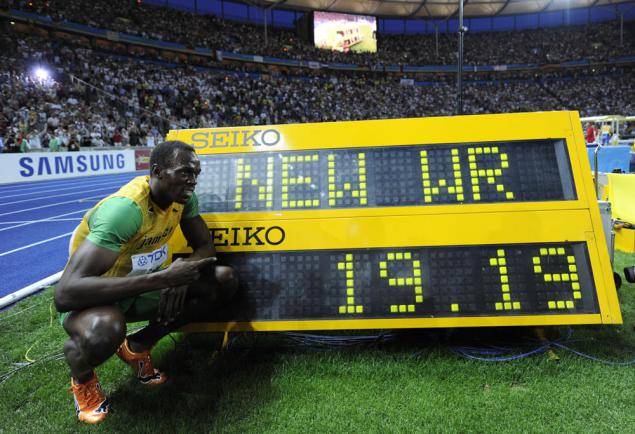
3 photo finish
Start using
In 1890, when only using the camera managed to find out which of the horses participating in the race, crossed the finish line first.
History
A photo finish was first officially used at the Olympic Games in Stockholm in 1912. Today he is one of the essential attributes of athletics, cycling and motor sports, "Formula 1", and a number of other species with a mass finish.
In 1926 there has been another technological breakthrough. Danish Athletics Federation presented a device that uses an accelerated filming. And in 1931 there was a so-called Kirby camera - High speed camera, allows to combine the photo finish and avtohronometrazh. It had two lenses, one was sent to the finishing line, the other shot chronometer starts from the starting pistol shot. The film was run inside the unit at record speed - 128 frames per second. The first production photo finish system - Racend OMEGA Timer, later renamed Photosprint - was presented in 1949 and in 1952 was used at the Winter Olympics in Oslo. It is this system that we owe the name "photo finish».
What has changed
By the beginning of the XXI century it has become a digital photo finish. Despite the constant improvement of the system Photosprint had a number of shortcomings. First of all, the film runs out quickly. In addition, there were occasions when it was torn and restive. In 1990 came the first digital photo finish system, at first they were used together with film sets. But gradually, the digital photo finish rid of flaws - low volume of vehicles and low-speed data transmission - bought a finished look and sent his celluloid ancestors in the museum.

4 Artificial ice
Start using
January 7, 1876 in London, opened the world's first artificial ice rink.
History
The first indoor ice rink was built in Canada in 1912 by brothers Joe and Lester Patrick. They thoroughly invested in innovation is paying huge sum in those days $ 110 thousand. Rink with a capacity for 4,000 people. In the second scene, the construction of which the engineers commissioned by the owners created the largest cooling system in the world, Patrick had already paid $ 210 thousand. This rink has been able to take more than 10 thousand. Man. Many financiers believed that the brothers facing imminent bankruptcy. But they were wrong. The matter was so lucrative that later Patrika opened hundreds of ice arenas in Canada and the United States.
It is also curious story of improved technology namorozki ice. At first it rolled by hand, and it was extremely difficult and lengthy process: water was supplied from a hose and shovels, special knives and towels workers leveled the ice. In 40-ies of XX century another Canadian Frank Zamboni has developed the world's first ice harvester. At first they were made on the basis of army jeeps, and today, when the number of ice rinks around the world is enormous, serial production of these machines. To align the ice is usually used two combine, they are the arena for three minutes.
What has changed
In place of the rink with artificial ice rink synthetic gradually coming. Its coverage includes hot plates, a polyolefin-based and allows you to ride on conventional skates with metal blades. These rollers were even cheaper than those using artificial ice, they are easy to use and more reliable, and therefore are becoming more common in Canada, the US and Europe.

5 Artificial lighting
Start using
In 1878 in England, the first football match under floodlights.
History
Before the invention of electricity all sports events in stadiums conducted during daylight hours. Then existing gas lamps could not provide enough light for a large playground. Electric lamp immediately found application not only in everyday life but also in sports. In 1878, the two clubs County Sheffield held at the stadium "Bremell Lane" match light bulbs mounted on wooden poles height of about nine meters and connected by wires to several dynamos. Light they gave quite a bit, so in 1892 the Scottish "Celtic" has decided to improve the idea of hanging garlands over a field of dozens of powerful lamps. However, this venture was abandoned, as the ball hit the wires periodically and beat bulb.
Electrification of sports facilities was slow because it was not absolutely necessary. Mass equipping stadiums began in the second half of the twentieth century thanks to the development of television: broadcasting of matches with dramatically increased requirements for artificial lighting.
What has changed
Today, sports coverage - it is a separate industry in which there are their standards and rules. There are standards governing what should be illuminated football fields, tennis courts and other venues. In addition to the brightness of light in the design of sports arenas and take into account indicators such as the uniformity of illumination. To do this, spotlights are increasingly installed in freestanding masts, and the top of the stadium designs.

6 Indoor Stadium
Start using
In 1899 in Montreal, it was built the world's first domed stadium for the game of hockey.
History
Covered stadiums needed mainly, where the weather is not conducive to long sitting in the stands under the open sky. In football widespread they received in 1950-1960-ies. Today, the largest indoor stadium in the world is the "Superdome" in New Orleans, it holds 72,968 spectators. The building is not so large-scale indoor sports facilities is much cheaper, so sports such as volleyball, basketball, hockey, handball and many other long moved under the roof.
There is a reverse situation. In tropical countries, where the sun shines all year round, thanks to modern technology built ski slopes. The first set of this kind - Thebarton, opened in 1987 in the Australian Adelaide - now considered one of the most humble. And the biggest built a few years ago in the Arabian desert. The initiator was the head of the Emirate of Dubai, Sheikh Mohammed bin Rashid Al Maktoum. Ski Stadium Ski Dubai accommodates five runs, the longest of which lasted for 400 m. In addition, there are trails for snowboarding and bobsleigh, toboggan track and "snow shooting" and the ice cave for children.
What has changed
Nowadays the convenience of covered stadiums recognized by all, so in those places where it is needed, a new sports facility just do indoor or equipped with a retractable roof. The latest example of this kind - a sliding roof, which was built over the Wimbledon Centre Court.
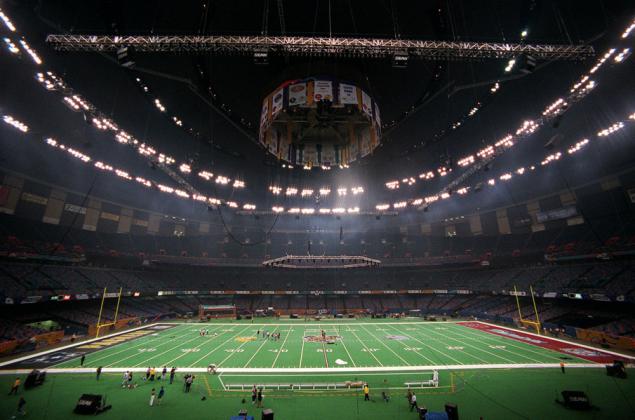
7 Doping
Start using
1865 - the first documented case of doping Dutch swimmers.
History
In fact, the history of doping has about the same age as the sport itself. People are always trying to increase the capacity of the human body, so carefully studied what the substance helps athletes perform better. The ancient athletes used doping, however, when he was much more harmless. Among the most popular tools were hashish, mushrooms and even lamb testicles, which increases testosterone levels in men. In ancient Rome and ancient Egypt also enjoyed stimulating products. Athletes believed in the power of bovine blood, hooves pounded and honey and dates. By the beginning of the XX century as doping have been used to artificially synthesized codeine, caffeine, strychnine and other drugs that have repeatedly led to the death of the athletes.
What has changed
The first attempts to fight against doping began in 1928, when the International Amateur Athletic Federation (IAAF) has banned the use of stimulant medications in their disciplines. However, consolidated resist doping began to have only in 1963. Then the Council of Europe set up a commission for the fight against illicit drugs in sport. The following year, the IOC Medical Code adopted, and in 1968 at the Olympics in Mexico City were introduced first tests for doping.

8 High-tech materials
Start using
1932, when the production of synthetic fibers in Germany.
History
To achieve the best results in sports, people were not limited to doping. The other side of sports perfection - the clothes, shoes and sports equipment themselves. With the invention of synthetic materials, the era of new technologies. In the second half of the twentieth century, several companies engaged in the use of new materials. In 1956 the company released the first Speedo swimsuits made of nylon, and in 1969 American Bob Gore invented the membrane GORE-TEX, which does not pass into the moisture, but produces steam emanating from the body. This effect was achieved through special billions of microscopic pores. It has been applied in the production of sports outerwear.
The use of new materials for the manufacture of sports equipment also allowed to raise the bar of world records, six high-jump is now made of fiberglass, a boat for rowing - plastic.
What has changed
In modern sport is no room left natural fabrics. All over the world are constantly developing new and improved materials that improve the results. For example, in a bathing suit Speedo LZR Racer, which reduces water resistance by 24%, were beaten by 182 world records in swimming. To preserve the principles of equality in sport, many federations have tightened rules on equipment.

9 Media technology
Start using
April 11, 1921 held its first radio broadcast of a sporting event - a boxing match between John and Johnny Ray Dundee in Pittsburgh.
History
After the first sporting events in the sport began a real revolution. In May 1937, a trial was held the show on television excerpts of the final match of the FA Cup, and the first game in the air became a duel between the main structure and reservists London "Arsenal", which was held September 16, 1937. Then no one could have imagined that camera does not just make the sport accessible and popular, but also become an integral part of the championships. Gradually they began to play a special role videopovtory. With the development of television sounded louder demands to allow judges to access video replays during matches. Now they are used in ice hockey, tennis and rugby, well, football authorities have repeatedly resorted to the television image to address the issue of the disqualification of the offending player behind the referee.
What has changed
Today, new technology in the sport - it's not just television, constantly improve the show competitions. Actively developing computer programs to help athletes and coaches more effectively organize training, develop the technique. In football there are several expensive systems that enable the coach during the match shorthand tactical and technical actions of his team and the opponent and on this basis to adjust the game wards.
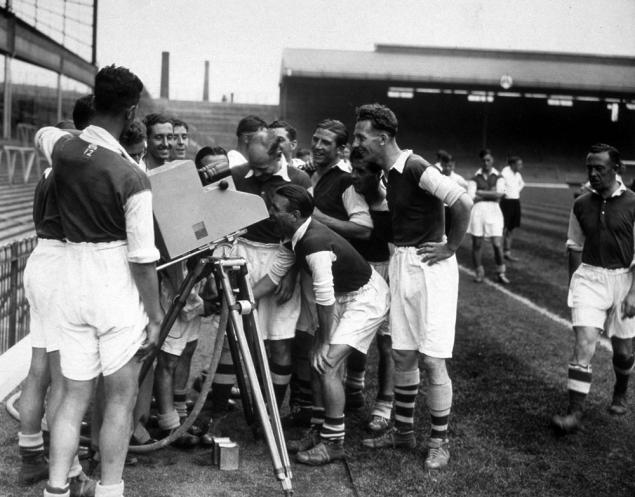
10 Trainers
Start using
At the beginning of the XIX century Swedish physician Henrik Ling, thanks gym to recover from paralysis of the arm, it comes up with the famous wall bars - the world's first simulator.
History
Until modern times came a few pictures of the second half of the XIX century, in which the patients of Dr. Gustav Zander (successor of the Linga) master trainers first. Then they have not been widely distributed throughout the world, and resembles a hybrid of modern and medieval Strength Training Torture. Swedish doctor named his method of physiotherapy mechanotherapy. In 1865 Gustav Zander founded a Medical-Mechanical Institute. He personally designed a set of devices that can justifiably be called the first simulators - in 1910 there were 70 different types. The doctor believed that his trainers suitable to all people without exception, and wrote in his work: "Hardware gymnastics is especially useful for children, as well as those elderly who do not have sufficient physical strength and can not engage in normal gymnastics." Although initially simulators used as medical devices, primarily for post-traumatic rehabilitation, they become part of the history of the sport. Today, both professionals and amateurs use them to maintain a good shape. There are also special trainers, which hone their skills skiers and racers.
What has changed
Today appeared on the market simulators without requiring them involved no effort: the so-called smart simulators provide a "fitness for the lazy", they act on different muscle groups. But, apparently, progress will not stop.
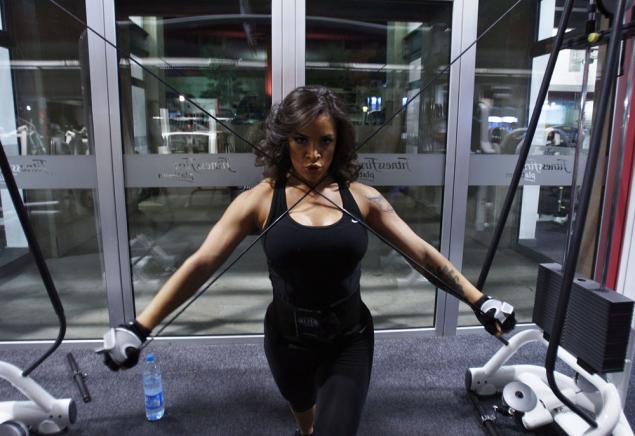
Source:
It's hard to imagine life without gadgets. Every day we are happy to use the benefits of civilization are not always aware of the fact how much has changed our daily existence. Sport, along with other spheres of life, too, was another - the invention of the twentieth century turned it into an exact science.
10 photos via rusrep.ru
1 electronic board
Start using
In 1964, an English football club, "Coventry" was first set at its stadium electronic scoreboard.
History
The first stadium scoreboards were mechanical. They used plates that had to be rearranged manually wheels and rails with figures moved along the windows, and the flip of a hard material. Of course, for such a service board was needed people is always close to him. Another disadvantage of mechanical scoreboard - the minimum information that it is able to display. Bill and team names - a larger count is not necessary. Later, there were electromechanical scoreboards. They differ from their predecessors was that they were equipped with motors or solenoids for remote switching of mechanical elements.
The new era of stadium scoreboards came after 1961, when the Americans Robert Bayard and Gary Pittman discovered and patented technology of infrared LEDs. However, in parallel with the LEDs in the stadiums has long been used incandescent lamps. At the Olympics-80 in Moscow thanks to the scoreboard showed a broadcast from the competition, but only in black and white.
What has changed:

Today, almost all major stadiums are equipped with video screens on which you can display the television picture, which is especially useful in such sports as biathlon or auto racing, where the viewer can not see the entire route. In addition to the score, you can find any statistical information about the players during the match broadcast or even see other competitions, as well as advertising - modern screens are almost universal.
2 Timing
Start using
Time in the sport for the first time was measured in seconds on the equestrian competitions in England in 1731.
History
First Chronograph, suitable for sports events, was made in 1820 by Swiss watchmaker Abraham-Louis Breguet. His creation is distinguished by the fact that there had been two second hands to fix the results of the two athletes. Gradually watchmakers improve its products, and already in 1862, the result can be measured with an accuracy of 1/5 of a second. Soon, however, and such accuracy was not enough, and in 1902 set a new standard - 0, 1 second. Since 1930 at the finish line began to mount the device with precision timing 0, 01 seconds. Watch companies are constantly working on improving the chronometers. At the Olympic Games in Mexico City in 1968, it has already reached the accuracy of 0, 001 seconds, and three years later came the first electronic stopwatch.
What has changed
Since 1973, the sports records in athletics is measured with an accuracy of 0 0001 second synchronizing via radio and the official chronograph quartz oscilloscope. In parallel, new developments emerged in other sports. So, thanks to the company Rado can instantly measure the flow rate of a tennis ball, and for swimmers by Omega in 1967 developed the so-called touch panel, which respond only to touch the athlete, ignoring the noise from the waves and water. At the 1972 Olympics in Munich thanks to them the Swede Gunnar Larsson at 0 0025 seconds (!) Ahead of American Tim McKee to swim the 400 meters freestyle.

3 photo finish
Start using
In 1890, when only using the camera managed to find out which of the horses participating in the race, crossed the finish line first.
History
A photo finish was first officially used at the Olympic Games in Stockholm in 1912. Today he is one of the essential attributes of athletics, cycling and motor sports, "Formula 1", and a number of other species with a mass finish.
In 1926 there has been another technological breakthrough. Danish Athletics Federation presented a device that uses an accelerated filming. And in 1931 there was a so-called Kirby camera - High speed camera, allows to combine the photo finish and avtohronometrazh. It had two lenses, one was sent to the finishing line, the other shot chronometer starts from the starting pistol shot. The film was run inside the unit at record speed - 128 frames per second. The first production photo finish system - Racend OMEGA Timer, later renamed Photosprint - was presented in 1949 and in 1952 was used at the Winter Olympics in Oslo. It is this system that we owe the name "photo finish».
What has changed
By the beginning of the XXI century it has become a digital photo finish. Despite the constant improvement of the system Photosprint had a number of shortcomings. First of all, the film runs out quickly. In addition, there were occasions when it was torn and restive. In 1990 came the first digital photo finish system, at first they were used together with film sets. But gradually, the digital photo finish rid of flaws - low volume of vehicles and low-speed data transmission - bought a finished look and sent his celluloid ancestors in the museum.

4 Artificial ice
Start using
January 7, 1876 in London, opened the world's first artificial ice rink.
History
The first indoor ice rink was built in Canada in 1912 by brothers Joe and Lester Patrick. They thoroughly invested in innovation is paying huge sum in those days $ 110 thousand. Rink with a capacity for 4,000 people. In the second scene, the construction of which the engineers commissioned by the owners created the largest cooling system in the world, Patrick had already paid $ 210 thousand. This rink has been able to take more than 10 thousand. Man. Many financiers believed that the brothers facing imminent bankruptcy. But they were wrong. The matter was so lucrative that later Patrika opened hundreds of ice arenas in Canada and the United States.
It is also curious story of improved technology namorozki ice. At first it rolled by hand, and it was extremely difficult and lengthy process: water was supplied from a hose and shovels, special knives and towels workers leveled the ice. In 40-ies of XX century another Canadian Frank Zamboni has developed the world's first ice harvester. At first they were made on the basis of army jeeps, and today, when the number of ice rinks around the world is enormous, serial production of these machines. To align the ice is usually used two combine, they are the arena for three minutes.
What has changed
In place of the rink with artificial ice rink synthetic gradually coming. Its coverage includes hot plates, a polyolefin-based and allows you to ride on conventional skates with metal blades. These rollers were even cheaper than those using artificial ice, they are easy to use and more reliable, and therefore are becoming more common in Canada, the US and Europe.

5 Artificial lighting
Start using
In 1878 in England, the first football match under floodlights.
History
Before the invention of electricity all sports events in stadiums conducted during daylight hours. Then existing gas lamps could not provide enough light for a large playground. Electric lamp immediately found application not only in everyday life but also in sports. In 1878, the two clubs County Sheffield held at the stadium "Bremell Lane" match light bulbs mounted on wooden poles height of about nine meters and connected by wires to several dynamos. Light they gave quite a bit, so in 1892 the Scottish "Celtic" has decided to improve the idea of hanging garlands over a field of dozens of powerful lamps. However, this venture was abandoned, as the ball hit the wires periodically and beat bulb.
Electrification of sports facilities was slow because it was not absolutely necessary. Mass equipping stadiums began in the second half of the twentieth century thanks to the development of television: broadcasting of matches with dramatically increased requirements for artificial lighting.
What has changed
Today, sports coverage - it is a separate industry in which there are their standards and rules. There are standards governing what should be illuminated football fields, tennis courts and other venues. In addition to the brightness of light in the design of sports arenas and take into account indicators such as the uniformity of illumination. To do this, spotlights are increasingly installed in freestanding masts, and the top of the stadium designs.

6 Indoor Stadium
Start using
In 1899 in Montreal, it was built the world's first domed stadium for the game of hockey.
History
Covered stadiums needed mainly, where the weather is not conducive to long sitting in the stands under the open sky. In football widespread they received in 1950-1960-ies. Today, the largest indoor stadium in the world is the "Superdome" in New Orleans, it holds 72,968 spectators. The building is not so large-scale indoor sports facilities is much cheaper, so sports such as volleyball, basketball, hockey, handball and many other long moved under the roof.
There is a reverse situation. In tropical countries, where the sun shines all year round, thanks to modern technology built ski slopes. The first set of this kind - Thebarton, opened in 1987 in the Australian Adelaide - now considered one of the most humble. And the biggest built a few years ago in the Arabian desert. The initiator was the head of the Emirate of Dubai, Sheikh Mohammed bin Rashid Al Maktoum. Ski Stadium Ski Dubai accommodates five runs, the longest of which lasted for 400 m. In addition, there are trails for snowboarding and bobsleigh, toboggan track and "snow shooting" and the ice cave for children.
What has changed
Nowadays the convenience of covered stadiums recognized by all, so in those places where it is needed, a new sports facility just do indoor or equipped with a retractable roof. The latest example of this kind - a sliding roof, which was built over the Wimbledon Centre Court.

7 Doping
Start using
1865 - the first documented case of doping Dutch swimmers.
History
In fact, the history of doping has about the same age as the sport itself. People are always trying to increase the capacity of the human body, so carefully studied what the substance helps athletes perform better. The ancient athletes used doping, however, when he was much more harmless. Among the most popular tools were hashish, mushrooms and even lamb testicles, which increases testosterone levels in men. In ancient Rome and ancient Egypt also enjoyed stimulating products. Athletes believed in the power of bovine blood, hooves pounded and honey and dates. By the beginning of the XX century as doping have been used to artificially synthesized codeine, caffeine, strychnine and other drugs that have repeatedly led to the death of the athletes.
What has changed
The first attempts to fight against doping began in 1928, when the International Amateur Athletic Federation (IAAF) has banned the use of stimulant medications in their disciplines. However, consolidated resist doping began to have only in 1963. Then the Council of Europe set up a commission for the fight against illicit drugs in sport. The following year, the IOC Medical Code adopted, and in 1968 at the Olympics in Mexico City were introduced first tests for doping.

8 High-tech materials
Start using
1932, when the production of synthetic fibers in Germany.
History
To achieve the best results in sports, people were not limited to doping. The other side of sports perfection - the clothes, shoes and sports equipment themselves. With the invention of synthetic materials, the era of new technologies. In the second half of the twentieth century, several companies engaged in the use of new materials. In 1956 the company released the first Speedo swimsuits made of nylon, and in 1969 American Bob Gore invented the membrane GORE-TEX, which does not pass into the moisture, but produces steam emanating from the body. This effect was achieved through special billions of microscopic pores. It has been applied in the production of sports outerwear.
The use of new materials for the manufacture of sports equipment also allowed to raise the bar of world records, six high-jump is now made of fiberglass, a boat for rowing - plastic.
What has changed
In modern sport is no room left natural fabrics. All over the world are constantly developing new and improved materials that improve the results. For example, in a bathing suit Speedo LZR Racer, which reduces water resistance by 24%, were beaten by 182 world records in swimming. To preserve the principles of equality in sport, many federations have tightened rules on equipment.

9 Media technology
Start using
April 11, 1921 held its first radio broadcast of a sporting event - a boxing match between John and Johnny Ray Dundee in Pittsburgh.
History
After the first sporting events in the sport began a real revolution. In May 1937, a trial was held the show on television excerpts of the final match of the FA Cup, and the first game in the air became a duel between the main structure and reservists London "Arsenal", which was held September 16, 1937. Then no one could have imagined that camera does not just make the sport accessible and popular, but also become an integral part of the championships. Gradually they began to play a special role videopovtory. With the development of television sounded louder demands to allow judges to access video replays during matches. Now they are used in ice hockey, tennis and rugby, well, football authorities have repeatedly resorted to the television image to address the issue of the disqualification of the offending player behind the referee.
What has changed
Today, new technology in the sport - it's not just television, constantly improve the show competitions. Actively developing computer programs to help athletes and coaches more effectively organize training, develop the technique. In football there are several expensive systems that enable the coach during the match shorthand tactical and technical actions of his team and the opponent and on this basis to adjust the game wards.

10 Trainers
Start using
At the beginning of the XIX century Swedish physician Henrik Ling, thanks gym to recover from paralysis of the arm, it comes up with the famous wall bars - the world's first simulator.
History
Until modern times came a few pictures of the second half of the XIX century, in which the patients of Dr. Gustav Zander (successor of the Linga) master trainers first. Then they have not been widely distributed throughout the world, and resembles a hybrid of modern and medieval Strength Training Torture. Swedish doctor named his method of physiotherapy mechanotherapy. In 1865 Gustav Zander founded a Medical-Mechanical Institute. He personally designed a set of devices that can justifiably be called the first simulators - in 1910 there were 70 different types. The doctor believed that his trainers suitable to all people without exception, and wrote in his work: "Hardware gymnastics is especially useful for children, as well as those elderly who do not have sufficient physical strength and can not engage in normal gymnastics." Although initially simulators used as medical devices, primarily for post-traumatic rehabilitation, they become part of the history of the sport. Today, both professionals and amateurs use them to maintain a good shape. There are also special trainers, which hone their skills skiers and racers.
What has changed
Today appeared on the market simulators without requiring them involved no effort: the so-called smart simulators provide a "fitness for the lazy", they act on different muscle groups. But, apparently, progress will not stop.

Source:



